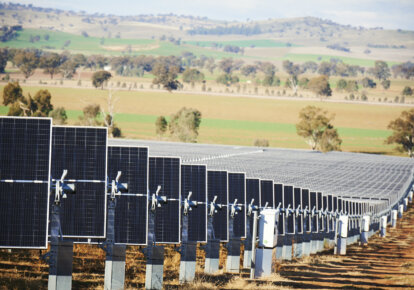In October, several new renewable generation records and minimum fossil generation records were set as high levels of solar and wind generation coincided with seasonally low spring demand. With the continuing renewable transition, these records were short lived and have since been broken at the beginning of November. Average spot prices were very low in the renewables-heavy states of Victoria and South Australia but were structurally higher in New South Wales and Queensland due to hotter weather and the interconnector between Victoria and New South Wales reaching its limits.
So far in November, there have been significant high wholesale prices in New South Wales and Queensland. Heat waves across these states coincided with transmission and generation outages (both planned and unplanned), pushing both demand and prices up. With the Bureau Of Meteorology predicting a greater than average likelihood of a hot summer to come, electricity consumers responding to price signals by adjusting electricity behaviour during high price periods will be crucial for minimising exposure to high price events.
Electricity price insights
47.7% of all electricity generated in October came from renewable sources across the network, hitting a record high thanks to high renewable generation and seasonally lower demand. South Australia had an 88% share of renewable generation, Victoria 49%, New South Wales 42% and Queensland 36%. Rooftop solar continued its strong year-on-year growth and captured a 16.8% share of National Electricity Market (NEM) demand in the month.
Renewable generation set a new instantaneous NEM-wide record, exceeding 75% generation share around midday at the end of the month, while coal and gas hit a record low share of 23.9%. Rooftop solar was meeting 51% of demand at the time and set a new record output.
South Australia hit a minimum demand record of –194 MW due to rooftop solar output exceeding demand in the state and the excess being exported via the interconnector with Victoria. Periods of excess renewable supply led to low prices, providing an incentive to shift electricity demand to these periods, helping to avoid renewable curtailment and save on electricity costs.
Negative prices were a strong feature during the month, starting as early as 8am and lasting until 4:30pm in Victoria and South Australia and 7:00am until 2:30pm in Queensland.
The strong renewable generation month resulted in average energy flows from Victoria and South Australia supplying north to New South Wales and Queensland. When the Victoria to New South Wales interconnector reaches its limit, prices between the states can separate – with lower cost generation not able to supply the higher price region. This occurred during October with average prices in New South Wales ($77) and Queensland ($71) more than twice as high as Victoria ($20) and South Australia ($35).
Changes in forward contract prices for CY25
Forward prices for 12-month futures in the three larger states saw a dip in the middle of October before rising again to similar, if not higher, prices by the end of the month. South Australia (which tends to trade less) saw continued falls throughout October.

- New South Wales prices are up 5% from a year ago, and 2% from September 2024
- Queensland prices are up 15% from a year ago, and 5% from September 2024
- South Australia prices are down 9% from a year ago, and 3% from September 2024
- Victoria prices are down up 6% from a year ago, and down less than 1% from September 2024
October 2024 NEM insights by state
New South Wales
- Average spot price of $77/MWh, with 114 hours of negative prices and 4 hours above $300/MWh
- $210/MWh difference in average underlying spot prices at the cheapest and most expensive times of day
- Only one interval had a negative average price throughout the month, though prices were typically lower through the middle-of-the day period
- A record 42% total renewable generation through the month
- New minimum demand record of 3,448 MW
- Peak demand of 9,093 MW
Queensland
- Average spot price of $71/MWh, with 236 hours of negative prices and 7 hours above $300/MWh
- $270/MWh difference between the average underlying prices at the cheapest and most expensive times of day
- Average prices were negative for all periods between 7:00 AM and 2:30 PM during the month
- A record 36% total renewable generation through the month
- Minimum demand of 3,645 MW
- Peak demand of 8,334 MW
South Australia
- Average spot price of $35/MWh, with 325 hours of negative prices and 2 hours above $300/MWh
- $250/MWh difference between the average underlying prices at the cheapest and most expensive times of the day
- Average prices were negative for all periods between 8:00 AM and 4:30 PM during the month
- A record 88% total renewable generation through the month
- New minimum demand record of –194.92 MW, meaning SA rooftop solar was generating more than the region required and exporting the excess
- Peak demand of 1,853 MW
Tasmania
- Average spot price of $50/MWh, with 74 hours of negative prices and 3 hours above $300/MWh
- $80/MWh difference between lowest and highest time-based average underlying spot price
- No daily intervals with an average negative price over the whole month
- More than 99% total renewable generation through the month
- Minimum record of 881 MW
- Peak demand of 1,517 MW
Victoria
- Average spot price of $20/MWh, with 298 hours of negative prices and less than 1 hour above $300/MWh
- $220/MWh difference between lowest and highest time-based average underlying spot price
- Average prices were negative for all periods between 8:00 AM and 4:30 PM during the month
- A record 49% total renewable generation through the month
- Minimum demand of 1,656 MW
- Peak demand of 6,662 MW
October temperatures
October mean temperatures across Australia came in at the second highest on record at 2.5oC above the long-term average. Queensland set the hottest mean October temperature on record. Heat wave conditions have covered much of Northern Australia at the end of October and into November. The BOM is predicting a higher-than-average likelihood of peak temperatures across Australia exceeding historic median levels through to the end of March.
October was a dry month for the main hydro catchments in Tasmania and the Snowy mountains as we reached the end of the usual winter inflow season with storages sitting below historic average levels.
Looking ahead to November 2024
As we transition into summer there is the likelihood of significant extremes in demand – from low daytime demand when there is strong rooftop solar generation, to high peak evening demand driven by heat waves. The first week of November has seen a significant heat wave across Australia, with temperatures up to 13o C above average. This heat wave has coincided with generation outages and a major transmission limitation in southern New South Wales to drive extreme evening peak prices in New South Wales and Queensland.
The scheduled transmission outage in southern New South Wales limits the ability for generation from Victoria and Southern New South Wales to support the load in the rest of the state and Queensland. This outage is due to run for most of November and adds a heightened risk of high prices during this time, particularly during high demand periods.
Some of the generation outages that contributed to the high peak prices at the start of November were unplanned and are expected to return to service in the near-term, helping to restore the supply/demand balance. Most of the major scheduled maintenance is due to be completed by early December.
As weather conditions have become more variable, it has become increasingly difficult for major generating units to plan scheduled maintenance. Historically, spring was typically a safe shoulder season to undertake maintenance ahead of the peak summer period. However, the periods where generators can undertake their scheduled maintenance may shrink if spring weather becomes hotter or more variable. New South Wales, Queensland and South Australia have experienced the highest spring temperatures in four years this week, with the outlook for the coming summer months to be hotter than average.
As a reminder, ongoing maintenance of both generating units and transmission lines could cause periods of high price volatility, particularly in the evening peaks or in South Australia where interconnection with the rest of the NEM is weaker.
The Bureau’s climate models remain in a weak “La Niña Watch” indicating that there are signs a La Niña may develop later this year. This would bring cooler than average maximum temperatures across most of mainland Australia (south of the tropics) and increased rainfall. The signals of a La Niña have been weakening, with increasing likelihood of a neutral El Niño–Southern Oscillation event. Looking further, current modelling indicates that if La Niña conditions were to develop, it would be relatively weak and short lived.
Any questions? Our energy specialists are here to help.
If you’re an existing Flow Power customer, don’t hesitate to reach out to your account manager.
If you’re not a Flow Power customer, feel free to contact our friendly team:
1300 08 06 08
Alternatively, you can submit your questions through our website contact form here.













